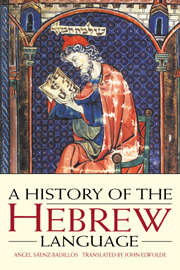Book contents
- Frontmatter
- Contents
- Foreword by Shelomo Morag
- Acknowledgements
- 1 Hebrew in the context of the Semitic languages
- 2 Hebrew, a Northwest Semitic language
- 3 Pre-exilic Hebrew
- 4 Biblical Hebrew in its various traditions
- 5 Hebrew in the period of the Second Temple
- 6 Rabbinic Hebrew
- 7 Mediaeval Hebrew
- 8 Modern Hebrew
- Bibliography
- Index
2 - Hebrew, a Northwest Semitic language
Published online by Cambridge University Press: 05 June 2012
- Frontmatter
- Contents
- Foreword by Shelomo Morag
- Acknowledgements
- 1 Hebrew in the context of the Semitic languages
- 2 Hebrew, a Northwest Semitic language
- 3 Pre-exilic Hebrew
- 4 Biblical Hebrew in its various traditions
- 5 Hebrew in the period of the Second Temple
- 6 Rabbinic Hebrew
- 7 Mediaeval Hebrew
- 8 Modern Hebrew
- Bibliography
- Index
Summary
The Northwest Semitic languages
The geographical and historical facts of Hebrew place it within the Northwest Semitic group of languages. Recent archaeological and epigraphic discoveries have been of critical importance in increasing our knowledge about the linguistic geography of this group, although on occasions the scarcity of evidence still prohibits a precise evaluation of the characteristics and peculiarities of these languages or dialects and of the relationships they have with one another.
As against the traditional classification of Northwest Semitic into two subgroups, Canaanite and Aramaic, the tendency nowadays is to accept the proposition of S. Moscati and G. Garbini that before the first millennium BCE one cannot speak of a contrast between Canaanite and Aramaic, but rather of a group of languages with various features in common. Less disputable is the exclusion from Northwest Semitic of Eblaite, attested in the north roughly halfway through the third millennium BCE, as already noted in Chapter 1.
The end of the third millennium saw the arrival in the east of Amorite. This language was spoken by a nomadic group called in cuneiform texts Amurru, who settled west of the Euphrates around Mari and used Akkadian in writing. A large number of proper names as well as some common nouns are virtually the sole remains of this Northwest Semitic language. The documents containing them were found mainly in Syria (Mari, Alalakh), and also in Mesopotamia (Ur). Following the early work of T. Bauer, who was the first to investigate the people he called ‘the East Canaanites’, there have been studies of some of the names, which date from 2300 to 1600 BCE.
- Type
- Chapter
- Information
- A History of the Hebrew Language , pp. 29 - 49Publisher: Cambridge University PressPrint publication year: 1993



